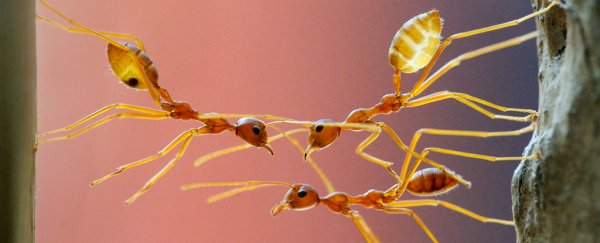Despite only having around 250,000 neurons compared to our 86 billion, ants can still achieve impressive feats when they team up. For starters, they're experts at avoiding traffic jams – a skill we humans could certainly benefit from – and individuals know when to quit to help make their team efforts more successful.
Now, researchers have filmed fire ants (Solenopsis invicta), notorious for their unpleasant but potentially useful stings, using these skills to pave their way over a sticky surface, forming a bridge to a delicious reward of sausage.
Another remarkable example of tool use in ants: fire ants “paving” sticky surfaces. I’ve seen signs of this behavior, but I didn’t expect it to be so robust until my friend told me about it (Wang et al., 2021 Insect Science). pic.twitter.com/BaHBmlgtXM
— Horace Zeng (@horacezhl) March 14, 2022
This species of ants is well known for creating bridges composed of their own bodies; they can also turn themselves into buoyant rafts to survive floods.
 A raft of ~500 fire ants along with SEM of how they link up. (Mlot et al., PNAS, 2011)
A raft of ~500 fire ants along with SEM of how they link up. (Mlot et al., PNAS, 2011)
They achieve their freaky floating rafts by clinging to each other using sticky feet pads, claw tips, and mouths (with careful delicate bites).
Each individual ant makes an average of 14 connections with neighboring ants, keeping themselves buoyant with bubbles formed with the aid of their water-repelling exoskeleton.
Ants also use tools to carry hard-to-relocate food such as liquids. They place debris such as dirt particles and leaves into the liquid and then carry the soaking tool back to their nest. Others have taken this further by using debris piles and paths as siphon tubes to reduce their risk of drowning.
 Ant bubbles and stick demonstrating raft buoyancy. (Mlot et al, PNAS, 2011)
Ant bubbles and stick demonstrating raft buoyancy. (Mlot et al, PNAS, 2011)
In a 2020 study, researchers from the South China Agricultural University demonstrated that ants can use surrounding debris (in this case soil particles) to create a bridge over a sticky, paraffin-smeared surface. But they would do this significantly more if food was within 20 centimeters (7.8 in).
"S. invicta searched and transported food items on viscose surfaces artificially covered with large amounts of particles but were not able to complete these activities on uncovered viscose surfaces or viscose surfaces that were covered with few particles," Chao Wen and colleagues wrote in their paper.
"However, ants also covered treated surfaces without real food, indicating that the inaccessibility of treated surfaces, rather than food, triggered the particle-covering behavior. Consequently, they may have evolved particle-covering behaviors to modify wet or inaccessible surfaces in their foraging territories to search and transport food, which may have provided them a competitive advantage over co-occurring ant species."
What's more, the ants were even able to build a soil 'bridge' across a surface smeared with a type of essential balm, considered to be a strong ant repellant.
University of Georgia entomologist Haolin Zeng highlighted one industrious worker ant during its mesmerizing bridge-building contribution on Twitter.
Here is a worker ant "paving" in real-time (I put a white circle around her); you can see her picking up the gravel, carrying it to the tape, putting it down, & doing it again. pic.twitter.com/zEIEBMmpT1
— Horace Zeng (@horacezhl) March 15, 2022
This ability to haul around particles – anything from glass to dirt – contributes to the important ecological process of bioturbation, the turnover of underground soil to the surface. Bioturbation significantly improves water permeability and the fertility of topsoil.
So, as annoying as these clever little beasties may be when we're out picnicking or if they invade our homes, they do also provide a huge service for our food growing. Thanks, ants – thants!
This research was published in Insect Science.
